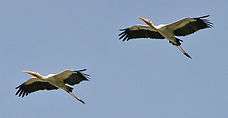Milky stork
| Milky stork | |
|---|---|
 | |
| Scientific classification | |
| Kingdom: | Animalia |
| Phylum: | Chordata |
| Class: | Aves |
| Order: | Ciconiiformes |
| Family: | Ciconiidae |
| Genus: | Mycteria |
| Species: | M. cinerea |
| Binomial name | |
| Mycteria cinerea Raffles, 1822 | |
.jpg)
The milky stork (Mycteria cinerea) is a large wading bird in the stork family Ciconiidae.
Description
This medium-sized stork can reach a height of 91 to 95 cm (36 to 37 in), with a wing chord length of 43.5–50 cm (17.1–19.7 in), a culmen length of 19.4–27.5 cm (7.6–10.8 in), a tarsus length of 18.8–25.5 cm (7.4–10.0 in) and a tail of 14.5–17 cm (5.7–6.7 in).[2] The sexes look similar. The plumage is generally creamy-white, hence the name "milky" stork. This is contrasted with a naked red face and a long shiny green-black tail and flight-feathers.
Distribution
This species occurs in Cambodia, peninsular Malaysia, and the Indonesian islands of Sumatra, Java, Bali, Sumbawa, Sulawesi, and Buton.
The milky stork can be found in coastal regions and favors mangroves and low-saline swamps of these areas.[3]
Feeding
The milky stork feeds on fish, amphibians, small rodents, prawns, and crabs. It finds its food on mudflats, saltwater pools, freshwater marshes, ponds, and rice fields.[3]
Breeding
The milky stork breeds in colonies during mating season. They most commonly breed during the non-rainy seasons of their habitat, being January and February in Cambodia and July and August in Indonesia. During this time, fish numbers have multiplied, increasing the storks' food supply. During mating season, the face and legs of the milky stork will turn bright red and the bill will turn a brighter orange.[4]

Milky storks make nests for their young in trees, generally 6 to 12 meters up. The storks lay around one to four eggs per season, and incubation time is around a month. After six to seven weeks, the young storks can leave the nest and start to fly, and will become adept fliers by around the eighth week. However, the young storks will still need their parents to provide food for them until they leave the nest for good. The young milky storks are cared for and fed by both the mother and father.[4]
Threats
It is classified as Endangered owing to loss of coastal habitat as well as hunting and trade. The storks' habitats are being diminished by logging and farming. In some areas, the birds, eggs, and chicks are being taken for domestication, food, or trade.[4]
Conservation Efforts
Efforts are being made to boost the bird's population to prevent it from going extinct. In Malaysia, programs have been instated to breed the storks domestically and release them into the wild. In Perak, Malaysia, actions are being taken to create laws of protection for the Matang Mangrove Forest Reserves.[3]
References
- ↑ BirdLife International (2013). "Mycteria cinerea". IUCN Red List of Threatened Species. Version 2013.2. International Union for Conservation of Nature. Retrieved 26 November 2013.
- ↑ Hancock & Kushan, Storks, Ibises and Spoonbills of the World. Princeton University Press (1992), ISBN 978-0-12-322730-0
- 1 2 3 "Milky Stork Mycteria cinerea". Birdlife International.
- 1 2 3 "Milky stork (Mycteria cinerea)". Wildscreen Arkive.
External links
| Wikimedia Commons has media related to Mycteria cinerea. |
| Wikispecies has information related to: Mycteria cinerea |
- Species factsheet - BirdLife International
| ||||||||||||||||||||||||||||||||||
